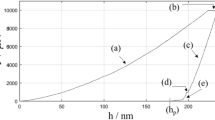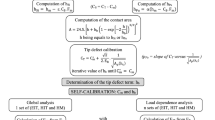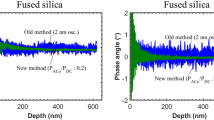Abstract
In the modern manufacturing industry, dealing with innovative productions and advanced materials, technological surface characterisation is becoming crucial to qualify components and optimise processes. Instrumented indentation test is an effective method for characterising mechanical behaviour of materials through the analysis of the force–displacement curve obtained during the implementation of a predefined loading/unloading cycle. Instrumented indentation test allows for hardness test to be performed at different force ranges, thus enabling bulk to local material characterisation. To guarantee the characterisation accuracy, rigorous procedures for the calibration of testing machines are defined in ISO 14577-2. In particular, calibration of frame compliance and indenter area function may be addressed according to methods which do not require the indenter area function to be known a priori, thus avoiding the need of high-resolution microscopes. The present work aims at comparing performances and compatibility of these methodologies by considering tests performed in the nano-range.






(Courtesy of Hysitron)





Similar content being viewed by others
References
Alekhin VP, Berlin GS, Shorshorov MC (1971) Instruments for micromechanical tests of solid materials. Instrum Exp Tech USSR 14(4):1265
Lucca DA, Herrmann K, Klopfstein MJ (2010) Nanoindentation: measuring methods and applications. CIRP Ann Manuf Technol 59(2):803–819
Doerner MF, Nix WD (1986) A method for interpreting the data from depth-sensing indentation instruments. J Mater Res 1:601–609
Oliver WC, Pharr GM (1992) An improved technique for determining hardness and elastic modulus using load and displacement sensing indentation experiments. J Mater Res 7(6):1564–1583
Oliver WC, Pharr GM (2004) Measurement of hardness and elastic modulus by instrumented indentation: advances in understanding and refinements to methodology. J Mater Res 19(1):3–20
ISO 14577-1:2015 Metallic materials-instrumented indentation test for hardness and materials parameters-part 1: test method. ISO, Genève, Switzerland
Engqvist H, Wiklund U (2004) Mapping of mechanical properties of WC–Co using nanoindentation. Tribol Lett 8(2–3):147–152
Nix WD, Gao H (1998) Indentation size effect in crystalline materials: a law for strain gradient plasticity. J Mech Phys Solids 46(3):411–425
Kim JY, Kang SK, Lee JJ, Jang J, Lee YH, Kwon D (2007) Influence of surface-roughness on indentation size effect. Acta Mater 55(10):3555–3562
Hou X, Jennett NM, Parlinska-Wojtan M (2013) Exploiting interactions between structure size and indentation size effects to determine the characteristic dimension of nano-structured materials by indentation. J Phys D Appl Phys 46(26):265301
Cagliero R, Barbato G, Maizza G, Genta G (2015) Measurement of elastic modulus by instrumented indentation in the macro-range: uncertainty evaluation. Int J Mech Sci 101–102:161–169
ISO 14577-2:2015 Metallic materials-instrumented indentation test for hardness and materials parameters-part 2: verification and calibration of testing machines. ISO, Genève, Switzerland
Barbato G, Genta G, Cagliero R, Galetto M, Hlopfstein MJ, Lucca DA, Levi R (2017) Uncertainty evaluation of indentation modulus in the nano-range: contact stiffness contribution. CIRP Ann Manuf Technol 66:495–498
Herrmann K, Jennet NM, Wegener W, Meneve J, Hasche K, Seeman R (2000) Progress in determination of the area function of indenters used for nanoindentation. Thin Solid Films 377–378:394–400
Meneve JL, Smith JF, Jennett NM, Saunders SRJ (1996) Surface mechanical property testing by depth sensing indentation. Appl Surf Sci 100–101:64–68
JCGM 100:2008, Evaluation of measurement data—guide to the expression of uncertainty in measurements (GUM), JCGM, Sèvres, France
JCGM 101:2008, Evaluation of measurement data—supplement 1 to the “Guide to the expression of uncertainty in measurement”—propagation of distributions using a Monte Carlo method, JCGM, Sèvres, France
Acknowledgements
The authors would like to thank Dr Massimo Lorusso of Istituto Italiano di Tecnologia for his availability and expertise in operating the testing equipment and for having performed the measurements.
Author information
Authors and Affiliations
Corresponding author
Rights and permissions
About this article
Cite this article
Galetto, M., Maculotti, G., Genta, G. et al. Instrumented Indentation Test in the Nano-range: Performances Comparison of Testing Machines Calibration Methods. Nanomanuf Metrol 2, 91–99 (2019). https://doi.org/10.1007/s41871-019-00035-5
Received:
Revised:
Accepted:
Published:
Issue Date:
DOI: https://doi.org/10.1007/s41871-019-00035-5




